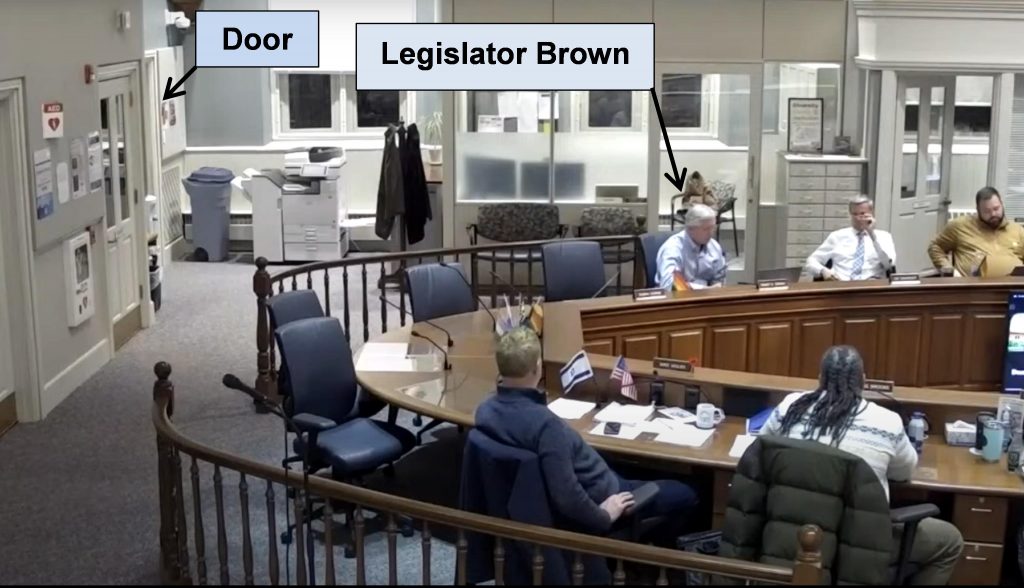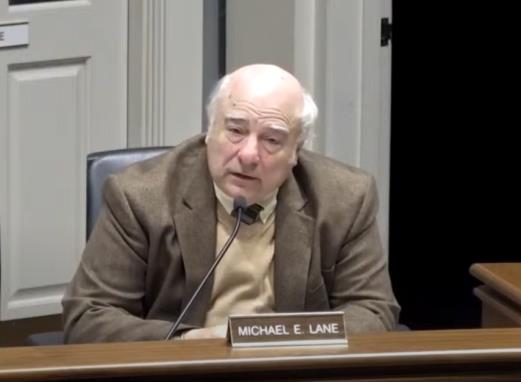Legislature hardens parkside access to chambers; routinely ratifies shelter site purchase

by Robert Lynch; December 4, 2024
It used to be that if you wanted to get a Certificate of Residency or visit Tompkins County Administration, you just walked into the Old Jail building, climbed the stairs or rode the elevator to the proper floor and walked right into an office. Former County Administrator Jason Molino put an end to that during the pandemic. Instead of easy access, you instead had to stand streetside in the rain or snow, buzz an intercom, and hope somebody would let you in. Post-COVID, no one ever changed it back.
And soon, the same aggravating, public-hostile security controls will expand in the building where the Tompkins County Legislature meets.

With only limited discussion and just one man’s dissent, the Legislature Tuesday endorsed a resolution authorizing facilities staff to “install a security camera/intercom system” at the DeWitt Park main entrance to the Governor Daniel D. Tompkins Building,” the place that houses legislative chambers.
By so doing, the County Legislature walked just one step short of imposing the burdensome magnetometer and bag-search procedures Ithaca’s City Hall has long required, surveillance implemented after an emotionally disturbed man famously threw his shoe toward former Mayor Carolyn Peterson at a Common Council meeting years ago.
“I don’t feel safe in this building, myself,” Newfield-Enfield legislator Randy Brown stated as he endorsed the new, ground-level security controls. “Every time that door opens in back of me, I have no idea what’s going on,” Brown said. “I hate having my back to the door. So I think this is a smart thing to do.”
But the main entrance’s lock downstairs won’t actually protect Randy Brown a single bit. State law requires open public meetings. So Legislature Clerk Katrina McCloy told lawmakers she’d unlock the door remotely a half-hour before a meeting starts, then relock it after the session adjourns. When Randy Brown’s attending, someone could still barge in.
“I don’t think it sends a very good message to the public,” Dryden’s Mike Lane, the evening’s lone dissenter, countered. “I just think we don’t need to be afraid of the public. That’s the message that it sends.”

When it comes to protecting legislative staff as well as building contents, what’ll be put in place now is but a second line of defense. For years, legislative staff has had a similar “buzz-in” intercom at the legislative chambers’ second-floor entrance. So all that the streetside door lock truly protects is a vestibule and stairwell to the building’s second floor.
But these days, governments’ default posture always leans toward overprotection. Maybe it comes from watching too much TV. Or in this instance, maybe County officials relied too heavily on a “Federal Cybersecurity and Infrastructure Security Agency Security Assessment at First Entry (SAFE)” evaluation which Uncle Sam supposedly performed on buildings in the Courthouse Complex last March. “SAFE,” according to the adopted resolution, recommended the tighter controls. At the time, nobody likely ever pushed back. Cybersecurity nerds seldom consider issues like open government.
“As the years go by, we are in different times,” legislator Travis Brooks observed. “I think people are under a false sense that if somebody came here to do harm, that we could get out, or that we could just press a button, or somebody could see it on the cameras and all of a sudden help us,” Brooks continued. “We don’t have superheroes like that. I don’t know why we don’t want to keep our staff safe and less vulnerable”

The County Planning Department occupies the ground floor of the Daniel Tompkins Building. The Resolution states that planners had no objections to the new locks. We’re told Planning, too, has a locked inner door.
But there’s an inherent danger in relying too heavily on blinders-on studies like the SAFE evaluation in setting your security priorities.
Quite obvious to anyone who frequents the Governor Daniel D. Tompkins Building or any other Courthouse Complex structure is not the threat posed by unlocked doors, but rather the danger one faces of getting mugged at night in an increasingly dangerous downtown Ithaca, including within DeWitt Park.
What a common-sense observer would conclude the Courthouse Complex really needs is the brighter lighting of parking lots, sidewalks, and entranceways, including the one now set to receive those semi-redundant cameras and an intercom.
****
The outcome was never in doubt, and the unanimous vote Tuesday among those present came as no surprise when the Legislature ratified the purchase announced last week of a decaying, metal-faced building at Ithaca’s 227 Cherry Street as the future site of a 100-bed homeless shelter.

No legislator spoke against the $1.1 Million purchase. Rather, most members occupied the three-hour meeting’s final moments congratulating each other for their mutual compassion and foresight.
Dryden legislator Greg Mezey moved the purchase resolution “with excitement and enthusiasm,” he said. From across the table, Lansing’s Mike Sigler asked the clerk to place Mezey’s adjectives into the record. So it went.
“Of course we should do this; it’s the right thing to do,” Dryden’s Mike Lane spoke up. Lane quoted an unnamed legislator from an unnamed county who said he was “envious” of what Tompkins was doing, because, in that legislator’s opinion, too many leaders elsewhere say “it’s not our problem.”
“Tompkins County has always had a forward-looking way of trying to handle difficult situations and to think about people,” Lane expounded. “And even if we miss sometimes, even if we don’t make it right every time, we always try, and we put our money where our mouth is.”

Legislator Deborah Dawson requested and received assurance that the night’s action would not commit Tompkins County to a “low-barrier” model for the shelter, a standard which might lead substance abusers and the mentally ill to populate the place.
But the assurance to Dawson did not stop Mezey from keeping a limited-barrier threshold under discussion or prevent others from urging that rules still apply.
“Sometimes this term ‘low-barrier’ gets a negative stigma or connotation,” Mezey told fellow legislators. “Just because we’re committed to looking at barriers doesn’t mean that we’re necessarily committed to a no-barrier or low-barrier shelter,” he said. “How do we look at what those are and systematically dismantle some of these barriers that are hindering getting people out of homelessness?”

“I do have real concerns about how this is executed,” a somewhat hesitant, yet still supportive, Rich John responded. “I don’t think the current approach is working very well… The evidence is that unrestricted drug use is really bad and dangerous and it’s killing people. I think we do need a new approach.”
Rich John had another caution: “I have real concerns for the residents of Nate’s Floral Estates (the planned shelter’s nearby mobile home park) and for the businesses on Cherry Street in the City’s Industrial Park. We need to be very cognizant of those neighbors, both commercial and residential, and as we go forward protect their interests to the maximum extent we can.”
County Administrator Lisa Holmes clarified the construction timetable. Most likely, she said, the current building would be pulled down next year, the new shelter started in 2026, with the shelter’s earliest opening likely in 2027.
“I think a lot of people think of this as an end and not a beginning,” Republican Sigler remarked of the approved land purchase. “I’d like to think of it the other way around… as the beginning and not the end.”
###

